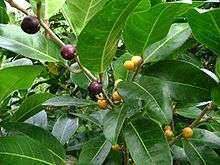Ficus tinctoria
Ficus tinctoria, also known as dye fig, or humped fig is a hemiepiphytic tree of genus Ficus. It is also one of the species known as strangler fig.[4]
| Dye fig | |
|---|---|
 | |
| Scientific classification | |
| Kingdom: | Plantae |
| Clade: | Tracheophytes |
| Clade: | Angiosperms |
| Clade: | Eudicots |
| Clade: | Rosids |
| Order: | Rosales |
| Family: | Moraceae |
| Genus: | Ficus |
| Species: | F. tinctoria |
| Binomial name | |
| Ficus tinctoria | |
| Synonyms[2] | |
|
List
| |
| Dye fig | |
|---|---|
| Scientific classification | |
| Kingdom: | |
| (unranked): | |
| (unranked): | |
| (unranked): | |
| Order: | |
| Family: | |
| Genus: | |
| Species: | F. tinctoria |
| Subspecies: | F. tinctoria subsp. gibbosa |
| Trinomial name | |
| Ficus tinctoria subsp. gibbosa (Blume) Corner | |
| Synonyms[3] | |
|
List
| |
It is found in Asia, Malesia, northern Australia, and the South Pacific islands.[4]
Palms are favorable host species. Root systems of dye fig can come together to be self sustaining but the epiphyte usually falls if the host tree dies or rots away.[5]
In Australia it is recorded as a medium-sized tree with smooth, oval green leaves.[4] It is found often growing in rocky areas or over boulders.[4] The leaves are asymmetrical.[6]
The small rust brown fruit of the dye fig are the source of a red dye used in traditional fabric making in parts of Oceania and Indonesia.
The fruit is also used for medicinal purposes.
Subspecies
Ficus tinctoria subsp. gibbosa is an accepted subspecies.[3]
References
- Botanic Gardens Conservation International (BGCI) & IUCN SSC Global Tree Specialist Group (2019). "Ficus tinctoria". IUCN Red List of Threatened Species. 2019: e.T143277299A143295549. Retrieved 11 February 2020.
- "The Plant List: F. tinctoria". Retrieved 22 April 2018.
- "The Plant List: F. tinctoria subsp. gibbosa". Retrieved 22 April 2018.
- Hyland, B. P. M.; Whiffin, T.; Zich, F. A.; et al. (Dec 2010). "Factsheet – Ficus tinctoria". Australian Tropical Rainforest Plants (6.1, online version RFK 6.1 ed.). Cairns, Australia: Commonwealth Scientific and Industrial Research Organisation (CSIRO), through its Division of Plant Industry; the Centre for Australian National Biodiversity Research; the Australian Tropical Herbarium, James Cook University. Retrieved 16 Mar 2013.
- Liu W., Wang P., Li J., Liu Wenyao, and Li Hongmei (2014), Plasticity of source‐water acquisition in epiphytic, transitional and terrestrial growth phases of Ficus tinctoria, Ecohydrol., 7; pages 1524–1533, doi:10.1002/eco.1475
- Janet Franklin; Gunnar Keppel; W. Arthur Whistler (2008). "The vegetation and flora of Lakeba, Nayau and Aiwa Islands, Central Lau Group, Fiji" (PDF). Micronesica. 40: 169–225. Archived from the original (PDF) on 2012-02-13.
